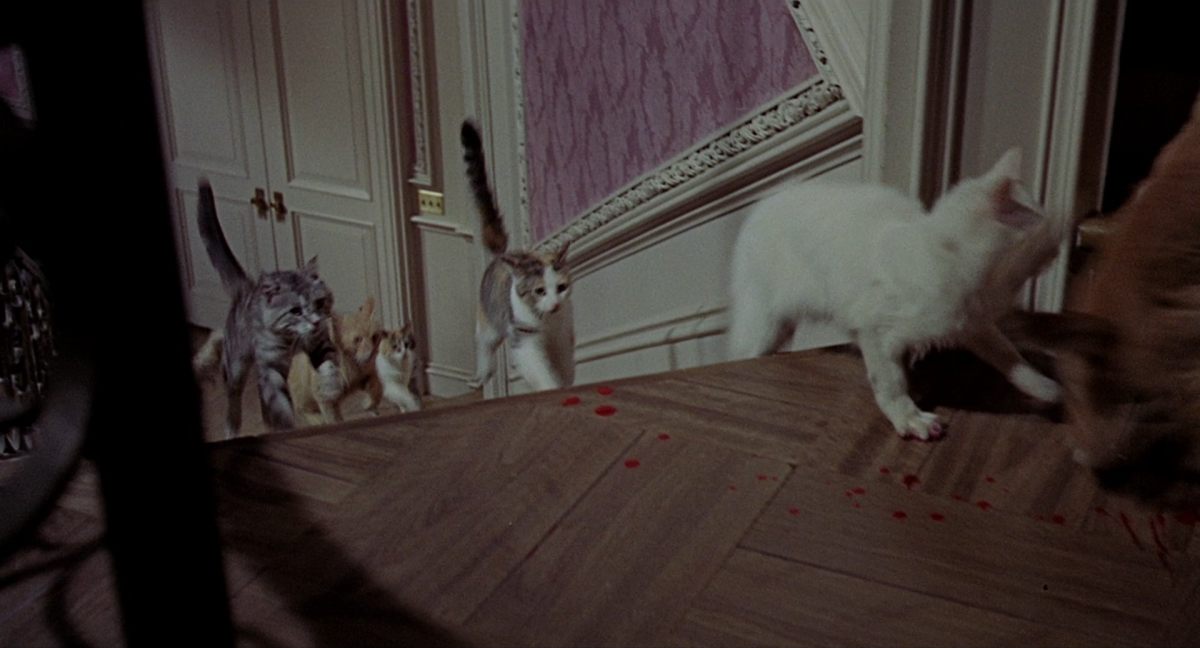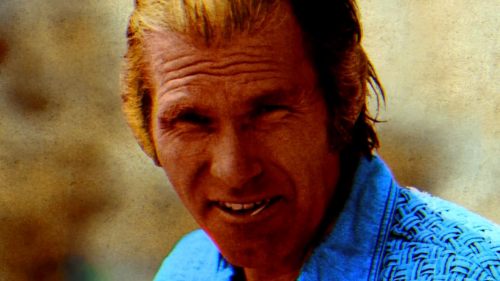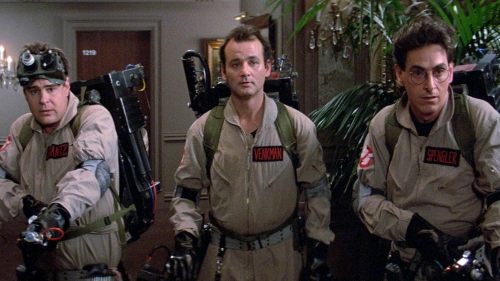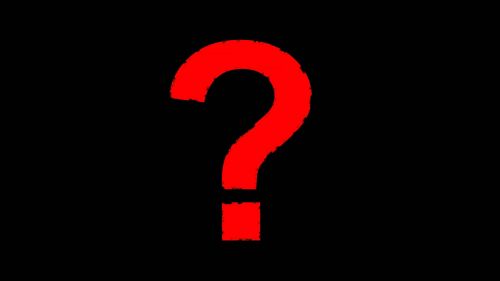Collins’ Crypt: A Eulogy For “Television Cuts”
At this point, most of the movies being released on Blu-ray by the boutique, collector-friendly labels have been out on DVD, sometimes even on Blu (albeit in less "special" form), so if a film you particularly like comes along from the likes of Arrow or Severin, it's a matter of "upgrading", not "finally owning for the first time". But there are some exceptions, one being the recent release of Eye of the Cat, a film I was quite charmed by when I saw it at the New Beverly several years ago. Scream Factory's release of the film isn't just the first time it's been on the high-def format - it's the first time it's been officially released on ANY home video format, at least in the US. Outside of bootlegs, there has been no way to properly watch this nearly fifty-year-old film at home if you lived in the country that it was made, which is insane for a production from a major studio (Universal, in this case) with recognizable actors like Eleanor Parker and Gayle Hunnicutt. This sort of treatment is what you'd expect from some weirdo outsider movie shot in Wisconsin or whatever - why Universal hadn't given it any love is a total mystery.
And it's one that won't be answered by the disc, as it lacks commentary or interviews that might answer such questions (can't blame Scream Factory for that really - the director, the screenwriter, the two lead actors, and the three credited producers are all deceased). But it's not barebones - along with the trailer and some stills, the disc offers the alternate television cut of the film, which is a wacky entry in the annals of such things. For those who haven't seen the film (probably most of you, due to the unavailability that's only been corrected in the past couple of weeks), it concerns a man named Wylie (Michael Sarrazin) who is roped into a scam by Kassia (Hunnicutt) in which he will earn the trust of his estranged aunt (Parker) and thus get her to change her will so that he gets everything, at which point they'll split the money. And who is currently set to inherit her fortune? Dozens of cats, of course, giving the movie an odd flavor in that viewers might hope she dies before she changes the will not to spite our scheming protagonists, but just to see what a bunch of cats would do with the money. The hitch in the plan stems from Wylie's ailurophobia, aka the fear of cats, and the meowing bastards seem to know what they're up to and keep getting in his way, leaving him paralyzed with fear time and time again.
Written by Joseph Stefano, it's basically a feature-length Alfred Hitchcock Presents episode (nearly every installment I ever saw involved some sort of inheritance scam), with the horror elements confined to only a few scenes. It's more like a goofy thriller than horror, in fact, probably due to the fact that the "villains" could not be counted on to do much in the way of on-screen terror. As any owner of one knows, cats won't do a goddamn thing you want them to, and even animal trainers can only do so much, so creative editing is responsible for making the cats "act" along with the story as required. Basically this means that any time there's a bunch of them in a scene the editor has to work overtime to make it look like they're doing anything menacing, employing the occasional jarring cut in order to keep things from looking too silly (like when Hunnicut is being "chased" by them and a couple run ahead of her, clearly not actually interested in their "prey"). The movie could probably be shorter/tighter, but there's a breezy charm to the whole thing I find quite endearing, and the scenes of dozens of cats crawling over each other to get at some meat are kind of unsettling in their own weird way.

Now, if you've only seen the TV cut of the film (again, the only one available for years), you're probably wondering what the hell I am talking about. Bizarrely, the television version focuses on one orange cat and cuts most of the footage of the others, padding the missing footage out with outtakes and a slightly extended finale to give the two versions roughly the same runtime, but a very different overall tone. Most of the other cuts make sense - there's a hint of incest that is dropped, and an earlier scene where a cat is electrocuted is excised, but for the life of me I can't figure out why they'd take out all the cat scenes in a killer cat movie, reducing its supernatural element to nothing. But it dawned on me while watching that version that, for several fans of the film, this largely cat-less take is probably the only version of the film they know, and will likely be shocked to watch the theatrical cut on the disc and see how all the cats play a part in the finale (and also that Wylie's aunt is kind of into him).
I also realized that this kind of thing was far more common in the 1980s, and has largely died out as a practice. During the early days of the format, VHS tapes were often incredibly expensive, and not everyone had HBO or Showtime, so the only way young horror fans such as myself could "own" a copy of a movie was to tape it during one of its network (and, later, basic cable) broadcasts and wear it out until some a better option came along. Usually this just meant we would get used to a Friday the 13th or Elm Street movie that lacked its gore and nudity, but every now and then a film would actually contain "new" or alternate footage, as the removal of certain scenes meant they had to fill that time back in somehow in order to bring the film back up to the required runtime for a network to air it (rounded out with commercials, of course). It's something we don't really see much anymore; "luckily", television stations have more commercials now than they did x number of years ago, so when a 90 minute film has a few seconds removed for whatever reason, it's no problem - they need to be down near 80 for it to be an issue these days. Likewise, while nudity is still a no-no, violence is not as taboo as it once was, and the level to which things need to be trimmed is night and day to how it was 20-30 years ago (filmmakers also began filming "clothed" versions of sex/nude scenes, so trims to those scenes are also minimal).
In most cases, the footage that was added back in was just padding that was cut for a reason; extra character scenes or people spending more time walking up stairs or something would be reinserted to get things up to the minimum runtime. Sometimes there would be a scene worth remembering, such as Child's Play 2 giving us an extra bit of reason to hate the snooty company jerk that Chucky kills in the car (we find out he's cheating on his wife), but by and large they were things we wouldn't miss, and didn't really change the film as a whole. Oddly, most of the exceptions to this rule involve John Carpenter, as there are major changes to the first two Halloween films, The Thing, and Prince of Darkness for when they showed on network TV. In Halloween's case, they didn't *have* any deleted footage of note to add back in once a few things were trimmed, which could have meant they'd have to cut even more out of the film and put it in a 90 minute block instead of a two hour one. Luckily, the NBC premiere happened to coincide with the production of Halloween II, so Carpenter grabbed a camera and the actors and shot a few new scenes that not only made up the time they'd need, but also helped cement the big twist that was designed for the sequel: the reveal that Laurie and Michael Myers were siblings. We now see Loomis entering Michael's room at Smith's Grove the morning after the escape and finding "SISTER" written on the wall, so when you watch this version back to back with Halloween II, it feels like foreshadowing a planned idea, as opposed to the out of nowhere dumb nonsense that it actually is.

For many fans, including me, this version is the one I first saw, and the one I had on tape, so all of these scenes were just as "canon" as anything else in the film, to the extent that the first time I saw it without them I thought I was watching a "cut" version until I was clued in. Thankfully I didn't have the same issue with Halloween II, which got its own television version in turn, though this time there wasn't any new footage being shot for it. Quite the opposite: the television cut is closer to the original cut of the film put together by director Rick Rosenthal, which was deemed un-scary and too gore-free to compete with the now heavy slasher movie competition. Carpenter again came to the rescue, reshooting some of the death scenes and adding a few bits here and there for its (successful) theatrical release, and that's the cut people tend to prefer. But the TV version fixes a few things that are amiss in the theatrical cut, most notably the fact that in that version it seems the sheriff is the last person in town to hear about the murders. Since all of the bodies are in the Wallace house and a very much out of it Laurie was found in the Doyle house, it makes sense that Annie, Lynda, and Bob were not found right away, but the theatrical cut has news reports about three bodies being found long before the sheriff is informed about it. This is because some of the scenes were rearranged, and more stuff with reporter Robert Mundy breathlessly recapping the events of the first film was added, without anyone giving much thought to how it created a bit of a plot hole with respect to the police.
But the biggest difference is that the ending is changed, allowing Lance Guest's character Jimmy - who is presumed dead in the theatrical cut - to definitively survive. The TV cut uses the clip of him slipping in Nurse Alves' blood and edits it in a way that makes it look like Loomis' explosion made him merely fall down, and then he survives, sharing the ambulance with Laurie the next morning. Again, most of the TV versions add things that are of no real consequence, so to see one that changes the fate of one of its major characters is strange, especially for those who grew up thinking the poor sod lived only to discover his (canon) death when they obtained a VHS or DVD of the theatrical version. Oddly, a few years later Guest took on an even bigger role in Jaws: The Revenge, and it too had a character who lived or died depending on which version you were watching. In the theatrical cut of the film, his buddy Jake (played by Mario Van Peebles) is eaten by the shark during the climax, but on the VHS release and subsequent TV versions, he manages to survive somehow (given his injury as shown, it'd be like Quint coming back to life in the original). For a while, AMC was showing the version where he died, but they've apparently gone back to the happier/stupider version in recent years. Netflix, thankfully, has the theatrical ending, though their license on the film is expiring soon, so get watching as the only other way to see Jake remain dead is to buy the Blu-ray, and no one wants to do that.
Back to Carpenter, for Prince of Darkness they bafflingly added a number of shots of Brian (Jameson Parker) sleeping, sprinkling them throughout the film to suggest he was sleeping the entire time, for reasons I can't begin to fathom (though props to this version being the rare instance where "It was all a dream!" wasn't presented as a twist - they were telling you all along!). As for The Thing, that's an interesting one in that it removes much of what makes the film such a beloved favorite (Rob Bottin's creature/gore FX), but the scenes that were added back in to bring the runtime back up to minimum are kind of fascinating in their own way, making me wish it was possible to have a composite cut of some sort, even if just for a one-off viewing. Along with the usual extra lines here and there, a narrator is added to give us some more biographical details about all of the characters, stuff that you'd never know otherwise. Did you know MacReady took the gig after being dismissed from the Army following a fight with one of his superiors? Or that Clark was doing a study on how the cold affected animal behavior? I don't know if this stuff came from Bill Lancaster's script or not, but it's interesting (albeit clunkily inserted) all the same, and while I never watch that version again (it's also cropped, so it can go to hell) I often recall this information when watching the theatrical cut, wondering what "personal tragedy in [Copper's] life sent him on this adventure". Also, the ending is different, replacing Carpenter's ambiguous one with, surprisingly, a darker one that cements the fact that the Thing has survived (via one of the dogs) and is making its way to the mainland, while the narrator tells us to keep watching everyone because "who knows what tomorrow will bring".

Unlike the other examples, I truly pity anyone who grew up with this version of the movie, due to all of the excised monster footage and ridiculous profanity dubs ("motherfucker" becomes "monkey fella" - better or worse than "Mr. Falcon"?). Then again, I'd love to watch their reaction to seeing the proper version for the first time, so there's some merit to it in a roundabout way. As for the others, you're bound to prefer one over the other depending on the one you watched the most during your formative years, and there's no right or wrong, really. No, I don't care much for Halloween being ret-conned to fit into the narrative of its inferior sequel, but I actually quite like the scene of Loomis talking to the doctors and warning them about Michael, prior to his escape, and as I mentioned Halloween II has problems either way, so I guess choosing which one is superior depends on how much you like Lance Guest (or nudity). And these aren't the only examples: Army of Darkness, C.H.U.D., H20, and Needful Things all offer otherwise unavailable footage when shown on television, and I'm sure there are others - feel free to list them below rather than just saying I "forgot" one without adding any context.
As I mentioned earlier, this unique mini-phenomenon has died out over the years. Movies like Halloween, Black Christmas, and others had big network debuts once upon a time, but nowadays, on the rare occasions the networks (NBC, ABC, etc) air movies at all, they tend to be family-oriented ones (often from their own film studio partners, such as NBC airing Universal films). With so many ways of accessing films, there is almost no reason to watch these films on broadcast TV with edits and commercials, so they simply stopped airing them. And on the rare occasions these movies air on basic cable (October, primarily), there's no real need for extra footage or anything like that - networks like AMC and TBS air just as many (if not more) commercials as the major networks but since they're less restrictive with what they show, little tends to be lost - certainly not enough to warrant digging in the vaults for something to pad the film's length to something reasonable. Things have changed so much that they don't even need the TV cuts for TV anymore; when Halloween shows on AMC, you don't get those extra Loomis scenes, and honestly I don't think I ever saw the "Jimmy lives" version of Halloween II until 2014, when it was placed on the boxed set as a bonus feature. They just use the theatrical cut, clip out the few bits they need to, and call it a day. The only way to see them is as supplements on their special editions, which is probably for the best, as that's all they really are in the end.
Still, it's an amusing little footnote for any number of genre films (and non-genre ones, of course), something I might even kind of miss in a way. Things like alternate endings and deleted scenes are commonplace on our discs, but they're presented separately, asking you to access them knowing perfectly well that they've been removed for one reason or another and you're only getting to see them out of your own curiosity. For the above examples - especially poor Eye of the Cat - that's just the way the movie WAS for any number of fans, and it can be kind of disorienting to discover that you were watching a reject cut for who knows how long. I mean, you were probably smart enough to notice a trimmed death scene or overdubbed bit of profanity, but why would anyone assume they were seeing a different ending than those who saw it in the theater? And on that note I'm kind of curious to know if anyone ended up sticking with the TV version once they got the proper one - do the theatrical versions feel "wrong" to you somehow? In Halloween's case it's easy to stick with the TV cut even once you know better, since there isn't much gore/nudity anyway and Carpenter, stickler for widescreen that he is, shot the TV scenes in 2.35, so that version of the film isn't even cropped. But for the others? Is it better to watch the film in a marginalized fashion to retain the narrative you're more comfortable with? Chime in below!
Loomis image courtesy of Brett Gallman.



